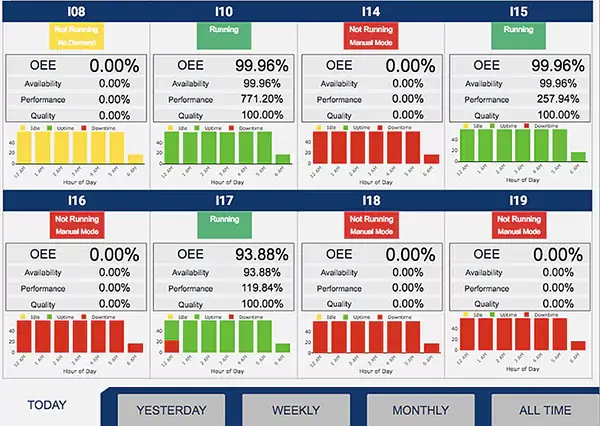As your products travel down the production line there is a split second of action that can have a significant impact on the productivity of the entire manufacturing process. Marking and coding holds a small yet mighty place on the factory floor, as those marks can often hold critical information for product safety and traceability. But oftentimes, this part of the process gets overlooked entirely or falls low on the list of focus areas when evaluating overall equipment effectiveness (OEE).
We believe it’s time to change that.
Integrate printing technology with OEE software
To gain the full benefit of an OEE program, it’s imperative that every piece of equipment on a given production line is fully integrated with your OEE software solution. This allows you to pinpoint inefficiencies quickly and take corrective action.
According to Source Forge, the integration across systems and OEE software “allows for more powerful process optimization, improved data collection and analysis, and better decision making.”
But this integration is only as good as the individual parts, including your marking and coding systems.
For many manufacturers, inkjet printers and labelers sit outside the OEE analysis. The working assumption is that the printers will work as expected and therefore don’t need to be included in OEE. Worse, they are often managed using rudimentary manual processes. As a result, unplanned stoppages, say to correct coding errors or to swap a failed ink cartridge, go unreported as OEE metrics suffer. And you’re not really sure why.
As noted by Mingo Smart Factory, “What’s measured gets managed. If you’re only measuring OEE and not looking at the factors that contribute to OEE, you will miss valid data points that can help you improve your manufacturing process. The process and discipline of collecting and looking at data are very important in creating a more efficient and effective factory floor.”
A marking and coding system that has an integrated controller with the ability to automate data flow across systems is your best bet for obtaining this more complete view. In turn, this level of visibility can support KPIs, team goals and clearly show opportunities for improvement.

To obtain a full picture of your production environment, your OEE dashboard needs to include data from your marking and coding systems.
More reliable printers + centralized platform = better OEE
The place to start is by first off making sure you’re using the most reliable print technology for the job at hand. For instance, many manufacturers are finding they can replace old, outdated carton marking technology with high maintenance costs for more reliable drop-on-demand (DoD) valvejet printers like the V-Series and quickly improve OEE metrics.
Once you have decided on the marking technology best suited for your application, the next step is to fully integrate print and labeling systems through a centralized controller such as the MPERIA automated marking platform that provides full visibility and control across primary, secondary and tertiary marking operations. This makes it easy to feed data into your OEE dashboards and identify where marking and coding could be impacting availability, performance or quality. With this data in hand, you can make the appropriate corrections in a timely fashion, helping to improve your OEE score and better meet customer demands.
Learn more about how centralized control can improve printing, marking and coding efficiency in our production automation blog post.
Start boosting your OEE with marking integration today — it’s easy
We’d love to tell you more or show you our products in action. Just complete the form below and we’ll be in touch right away. We look forward to hearing from you.
